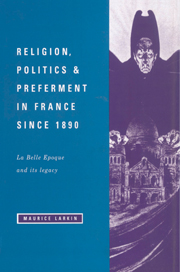Book contents
- Frontmatter
- Contents
- Preface
- Part 1 As it was: Catholics and the Republic, 1890–1914
- 1 Ralliés and dérailleurs: Catholics and subversion
- 2 Le sabre et le goupillon: Catholics and the Army
- 3 Raison d'état, raison d'église: the Roman dimension
- Part 2 As it was: Catholics and state employment, 1890–1914
- Part 3 As it became, 1914–1994
- Map: Religious observance in France, c. 1960.
- Notes
- Sources
- Index
3 - Raison d'état, raison d'église: the Roman dimension
Published online by Cambridge University Press: 27 January 2010
- Frontmatter
- Contents
- Preface
- Part 1 As it was: Catholics and the Republic, 1890–1914
- 1 Ralliés and dérailleurs: Catholics and subversion
- 2 Le sabre et le goupillon: Catholics and the Army
- 3 Raison d'état, raison d'église: the Roman dimension
- Part 2 As it was: Catholics and state employment, 1890–1914
- Part 3 As it became, 1914–1994
- Map: Religious observance in France, c. 1960.
- Notes
- Sources
- Index
Summary
A neglected source of suspicion that coloured Republican attitudes to committed Catholics was their ambivalent allegiance to a foreign figure, the Pope in Rome. The Roman dimension to the Catholic Church had been a major cause of friction in Church–State relations since the Middle Ages, leading to massive fissures in European Christianity in the eleventh and sixteenth centuries. But the French monarchy had learned to live with the situation by unilaterally inventing Gallican liberties which allowed it to regulate the communications between Rome and the faithful in France. Napoleon had continued the tradition in the Organic Articles that he had unilaterally attached to his Concordat with the Pope; and although these were never recognised by Rome, a tacit agreement to differ enabled the system to work after a fashion for much of the nineteenth century. But the loss of the Temporal Power in 1870 and the declaration of papal infallibility in matters of faith and morals tended to sharpen the spiritual allegiance of many Catholics to the See of Rome, and put new pressures on the easy-going tolerance of the Gallican mésentente cordiale. The advent of anticlerical secularising governments inevitably worsened matters, as did the anti-Republicanism of a large number of French Catholics. Leo XIII's Ralliement policies helped to alleviate tension in the 1890s, but, ironically, his conciliatory attitudes made French governments correspondingly aware of the dependence of tolerable Church–State relations on the personality and preoccupations of the Pope and his advisers.
- Type
- Chapter
- Information
- Religion, Politics and Preferment in France since 1890La Belle Epoque and its Legacy, pp. 53 - 68Publisher: Cambridge University PressPrint publication year: 1995



